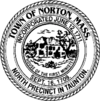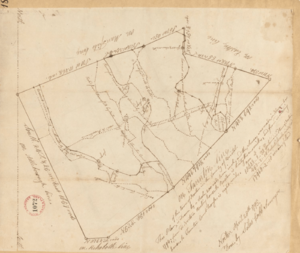Norton, Massachusetts facts for kids
Quick facts for kids
Norton, Massachusetts
|
||
|---|---|---|
| Town of Norton | ||

Norton Town Common
|
||
|
||

Location in Bristol County in Massachusetts
|
||
| Country | United States | |
| State | Massachusetts | |
| County | Bristol | |
| Settled | 1669 | |
| Incorporated | 1711 | |
| Government | ||
| • Type | Open town meeting | |
| Area | ||
| • Total | 29.8 sq mi (77.2 km2) | |
| • Land | 28.7 sq mi (74.4 km2) | |
| • Water | 1.1 sq mi (2.9 km2) | |
| Elevation | 105 ft (32 m) | |
| Population
(2020)
|
||
| • Total | 19,202 | |
| • Density | 644.4/sq mi (248.73/km2) | |
| Time zone | UTC−5 (Eastern) | |
| • Summer (DST) | UTC−4 (Eastern) | |
| ZIP Code |
02766
|
|
| Area code(s) | 508/774 | |
| FIPS code | 25-49970 | |
| GNIS feature ID | 0619436 | |
| Website | www.nortonma.org | |
Norton is a town in Bristol County, Massachusetts, United States. It includes the villages of Norton Center and Chartley. In 2020, about 19,202 people lived here.
Norton is home to Wheaton College. It also used to host a big golf tournament called the Dell Technologies Championship. This event was part of the PGA Tour and took place at the TPC Boston golf club until 2018.
Contents
History of Norton
English colonists did not settle the land where Norton is now for many years. But by the late 1640s, nearby towns like Rehoboth and Taunton wanted to grow.
In 1668, European colonists first settled Norton. This happened after the "Taunton North Purchase." This land deal with Metacomet, a Wampanoag leader, gave Taunton residents rights to the land north of their settlement. This area included forests, swamps, rivers, and lakes. It later became Norton, Mansfield, and Easton.
In 1686, more payments were made for the North Purchase lands. These were made to Wompatuck, a relative of Chickatawbut. During King Philip’s War, there was a conflict at a place called "Lockety Neck" in Norton. A memorial plaque on Pine Street remembers the Wampanoag families who were affected by this conflict.
When Norton was first settled in 1669, it was called North Taunton. This was because it was on the northern border of Taunton, Massachusetts. The town was renamed "Norton" on March 17, 1710. It was named after Norton, Oxfordshire, England, where many early settlers came from. Parts of Norton later became Easton (in 1725) and Mansfield (in 1770).
Metacomet, also known as "King Philip," was a Wampanoag Indian leader. He used to camp in a cave made of huge rocks near Lake Winnecunnet. This cave is known as King Philip's Cave. Many local children enjoy hearing the legends about it.
The bandstand in the town center was built with donated money during the first Gulf War. It honors the veterans from Norton who served.
Students in elementary school often hear the story of the "Devil's Foot Print." This legend says that Major George Leonard sold his soul to the devil. The devil's footprint can supposedly be seen at Norton's Joseph C. Solmonese Elementary School. This school is on land that used to be Leonard's farm. Every 26 years, the school opens a time capsule. The last one was buried in 1999 and will be opened in 2026.
Norton is a small town that is slowly changing. For example, the first full traffic light in town was installed in 1997. It was at the intersection of routes 123 and 140. This showed that Norton was growing and becoming more modern. Norton is also part of the Bridgewater Triangle, an area known for unusual events.
Geography and Travel in Norton
Norton covers about 29.8 square miles (77.2 square kilometers). Most of this area is land, with about 1.1 square miles (2.9 square kilometers) being water. The land in Norton is generally low and has some swampy areas.
Rivers like the Wading River and the Canoe River flow through Norton. These rivers eventually join the Taunton River. The two biggest bodies of water in town are the Norton Reservoir and Winnecunnet Pond. Lake Winnecunnet is Norton’s only natural lake. It formed over 13,000 years ago from melting glacial ice.
Norton is shaped like an irregular polygon. It is bordered by several other towns:
- Easton to the northeast
- Taunton to the southeast
- Rehoboth to the south
- Attleboro to the southwest
- Mansfield to the northwest
Norton is about 27 miles (43 km) south of Boston. It is also about 15 miles (24 km) northeast of Providence, Rhode Island.
Major roads in Norton include Interstate 495 and Massachusetts Routes 123 and 140. These routes meet in the center of town. There is an exit from I-495 for Route 123 in the eastern part of town.
The Greater Attleboro Taunton Regional Transit Authority (GATRA) has a bus route that goes through Norton. This bus connects Norton to Attleboro and Taunton. A railroad track, the Middleboro Subdivision, also crosses the southern part of town. For longer train trips, the Providence/Stoughton Line of the MBTA Commuter Rail has stops in nearby Attleboro and Mansfield. These lines provide train access to Providence and Boston.
The closest small airport is in Mansfield. For national and international flights, people usually go to Logan International Airport in Boston or T.F. Green Airport in Warwick, Rhode Island.
People in Norton
| Historical population | ||
|---|---|---|
| Year | Pop. | ±% |
| 1850 | 1,966 | — |
| 1860 | 1,848 | −6.0% |
| 1870 | 1,821 | −1.5% |
| 1880 | 1,782 | −2.1% |
| 1890 | 1,785 | +0.2% |
| 1900 | 1,826 | +2.3% |
| 1910 | 2,544 | +39.3% |
| 1920 | 2,374 | −6.7% |
| 1930 | 2,737 | +15.3% |
| 1940 | 3,107 | +13.5% |
| 1950 | 4,401 | +41.6% |
| 1960 | 6,818 | +54.9% |
| 1970 | 9,487 | +39.1% |
| 1980 | 12,690 | +33.8% |
| 1990 | 14,265 | +12.4% |
| 2000 | 18,036 | +26.4% |
| 2010 | 19,031 | +5.5% |
| 2020 | 19,202 | +0.9% |
| 2022 | 19,108 | −0.5% |
Source: United States Census records and Population Estimates Program data. |
||
In 2000, there were 18,036 people living in Norton. There were 5,872 households and 4,474 families. The population density was about 628 people per square mile. Most residents (92.15%) were White. About 1.16% were African American, and 1.00% were Asian. About 1.14% of the population was Hispanic or Latino.
Many households (42.3%) had children under 18 living with them. Most households (61.8%) were married couples. About 19.3% of households were single individuals. The average household had 2.79 people.
The population was spread out by age. About 27.0% were under 18 years old. About 12.6% were between 18 and 24. The median age in town was 33 years old.
In 2016, the average income for a household in Norton was about $80,806. For families, the average income was about $104,176. A small number of families (2.2%) and people (4.0%) had lower incomes.
Education in Norton
Norton has its own public school system, called Norton Public Schools. There are three elementary schools:
- L.G. Nourse Elementary School (Kindergarten to 3rd grade)
- J.C. Solomonese Elementary School (Pre-Kindergarten to 3rd grade)
- H.A. Yelle Elementary School (4th to 5th grade)
The Norton Middle School serves grades 6 through 8. Norton High School serves grades 9 through 12. The high school's colors are purple and white, and their mascot is a lancer.
High school students can also choose to attend other schools for free. These include Southeast Regional Vocational-Technical High School in Easton. Another option is Bristol County Agricultural High School, also known as "Bristol Aggie," in Dighton.
There are also two private schools in Norton:
- Life Church, a Baptist school for grades K–12.
- Pinecroft School on 33 Pine Street.
Many students also attend private schools in nearby towns. As mentioned, Norton is also home to Wheaton College, a higher education institution.
Notable People from Norton
- Troy Brown: A former New England Patriots wide receiver (football player).
- George L. Clarke (1813–1890): He was born in Norton and later became the Mayor of Providence from 1869 to 1870.
- Jonathan Eddy: A colonel who served in the American Revolution.
See also
 In Spanish: Norton (Massachusetts) para niños
In Spanish: Norton (Massachusetts) para niños



